Solar Glass
Glass and solar energy applications go hand in hand. Whether it is a photovoltaic, solar thermal, or concentrated solar power installation, glass is there in one form or the other. In all such applications, the quality of glass is primarily assessed by what it does to light incident on it. In addition there are other properties of mechanical and chemical nature which need to be specified.
For PV solar applications glass is used as the outer protective layer on the solar cell against environmental effects. Thus, it should have low reflectance (fraction of incident energy which is reflected back at the glass outer surface). Since air and glass have different refractive indices, reflectance cannot be zero. Hence, anti-reflective coatings are used. Anti-reflective coatings are actually very fine layers of a third material on the surface of glass which reduce reflection to nearly zero. They do this normally by creating double reflections such that the two almost cancel each other. Thus nearly all of the incident light can enter through. Similarly, reflection at the glass-solar cell interface can be mitigated by coatings to ensure maximum throughput of energy to the solar cell. The glass material itself should be transparent, that is, it should have nearly zero absorption. 
Concentrated solar power installations normally use reflectors or mirrors for concentration. A mirror glass will be coated at the rear surface to ensure a complete reflection. At the same time it should have as low absorption as possible. Windows for passive solar applications require glass that permits light to pass through but do not absorb light itself. However, soon we are going to have windows which will have dual, rather, triple roles. Specially treated translucent material based on perovskites will let some light pass, and convert the rest to electricity. At the same time it will reflect back most of the IR energy in the sunshine so that in tropical and equatorial locations the indoors or the window panes do not heat up.
Evacuated tube collectors (ETC) in solar thermal applications use the transparency and heat insulation property of glass. An evacuated transparent glass tube surrounds a thermal absorber tube. Sun’s rays pass through the transparent tube and heat the absorber. Heat collected by the absorber is prevented from escaping due to the vacuum and glass insulation. The heat is carried away by a fluid (air or water) passing through the collector and is used where desired.
